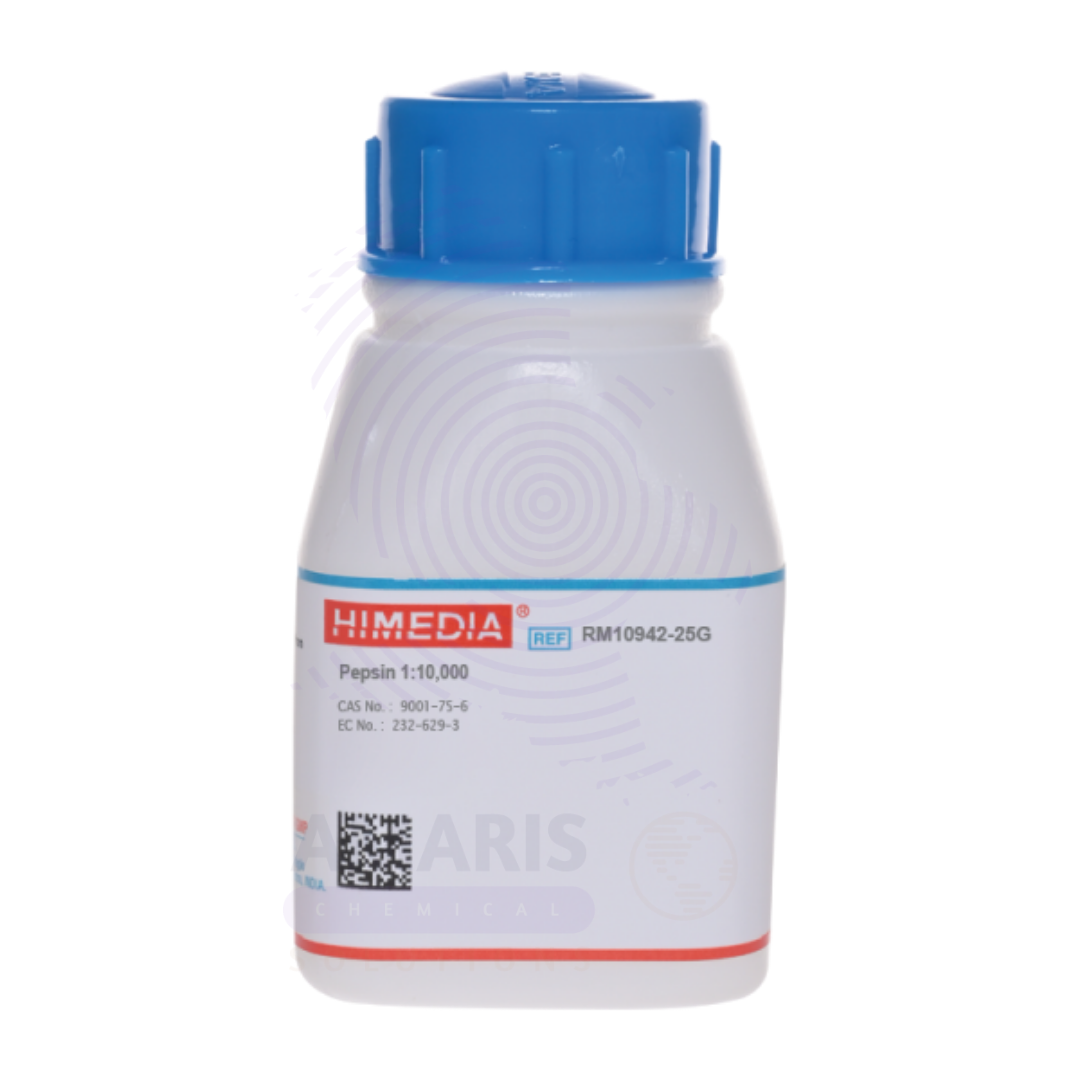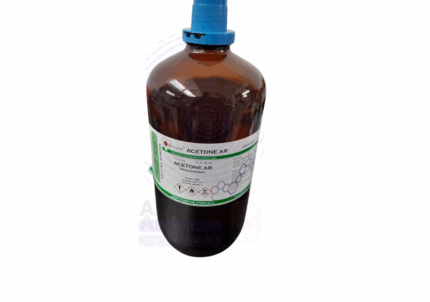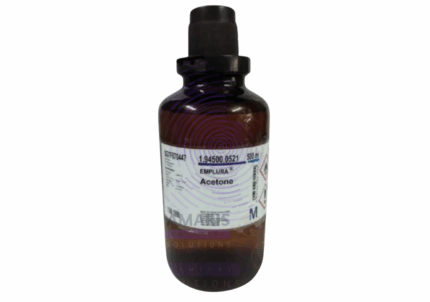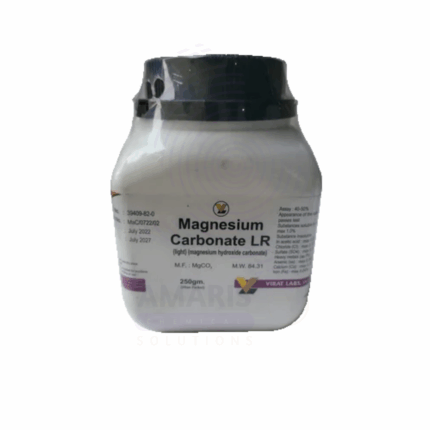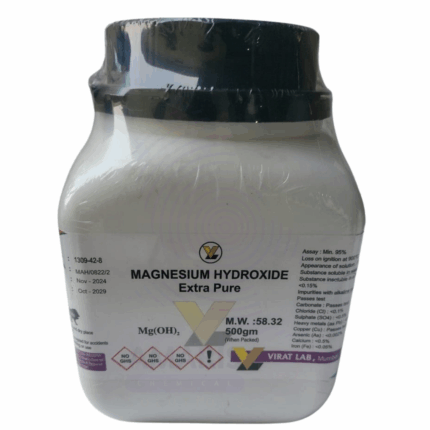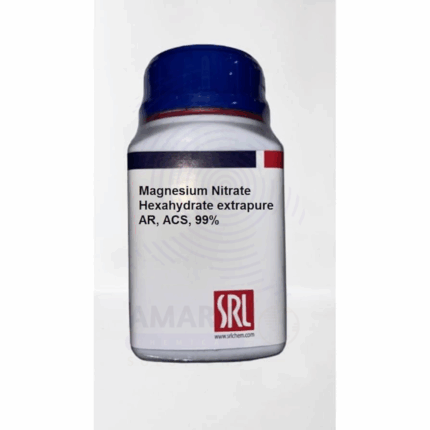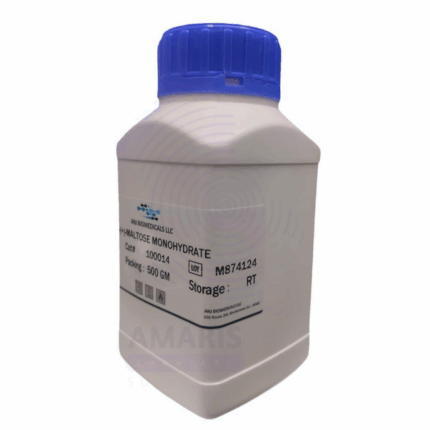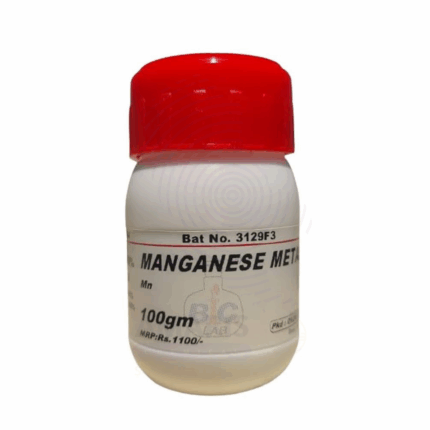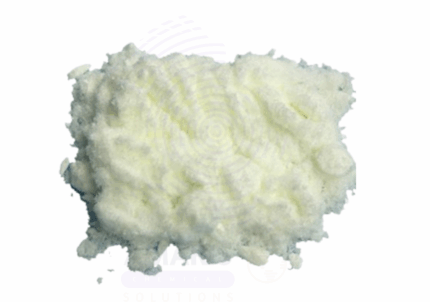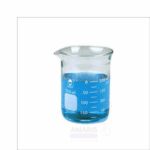

Pepsin Extra Pure
$ 19.00 Original price was: $ 19.00.$ 18.90Current price is: $ 18.90.
Pepsin Extra Pure is a highly refined proteolytic enzyme derived from porcine gastric mucosa, widely recognized for its ability to break down proteins into peptides. Appearing as a white to off-white, amorphous powder, it retains strong enzymatic activity and is soluble in dilute acids, making it ideal for biological and analytical applications.
This Extra Pure grade is extensively used in biochemical research, pharmaceutical formulations, digestive studies, and food processing, particularly in the production of protein hydrolysates. It plays a crucial role in simulating gastric digestion in lab experiments and is also employed in diagnostic preparations and enzyme assays. Pepsin should be stored in a tightly sealed container under refrigerated conditions to maintain its activity, and care should be taken to avoid exposure to moisture and alkaline conditions, which can denature the enzyme.
Pepsin Extra Pure
PRIMARY USES
- Used as a digestive enzyme in pharmaceutical preparations to aid protein digestion.
- Applied in clinical treatments for conditions like hypochlorhydria and achlorhydria.
- Essential in biochemical research for hydrolyzing proteins in enzyme activity studies.
- Used in laboratories for tissue dissociation in histology and cell isolation procedures.
- Employed in immunology and proteomics to prepare peptide fragments for analysis.
SECONDARY USES
- Utilized in the food industry for producing protein hydrolysates and flavor enhancers.
- Helps in the production of gelatin by breaking down collagen in animal tissues.
- Occasionally used in the clarification of broths and meat extracts.
- Included in cosmetic formulations as a mild enzymatic exfoliant.
- Applied in forensic science and pathology for tissue digestion protocols in specimen preparation.
1. Basic Identification Attributes
- Chemical Name: Pepsin
- CAS Number: 9001-75-6
- HS Code: 3507.90.00
- Molecular Formula: C₁₂₂H₁₇₄N₃₂O₃₃ (approximate, varies slightly by source)
- Synonyms:
- Pepsin A
- Gastricsin
- Proteolytic enzyme
- EC 3.4.23.1 (Enzyme Commission number)
2. Physical & Chemical Properties
- Physical State: Powder or crystalline solid
- Color & Odor: White to off-white; odorless or faint protein-like odor
- Boiling Point & Melting Point: Not applicable (denatures before boiling)
- Density: Not well defined; enzyme preparations are often light and fluffy
- Solubility:
- Soluble in water (forms active enzyme solution)
- Insoluble in organic solvents
- pH Level: Optimum enzymatic activity at pH 1.5 to 2.5
- Vapor Pressure & Volatility: Not volatile
- Flash Point: Not applicable (non-flammable)
- Autoignition Temperature: Not applicable
- Viscosity: Not applicable in dry form
3. Safety & Hazard Attributes
- Hazard Class (GHS Classification):
- May cause allergic reactions via inhalation (Respiratory sensitizer – GHS H334)
- May cause skin and eye irritation
- NFPA Ratings:
- Health: 2
- Flammability: 0
- Reactivity: 0
- Exposure Limits:
- No specific OSHA or ACGIH limits; minimize dust exposure
- Reactivity:
- Stable under recommended storage conditions
- Denatures in alkaline or very high-temperature environments
4. Storage & Handling Attributes
- Storage Conditions:
- Store in cool, dry conditions (2–8 °C recommended)
- Protect from moisture and heat
- Incompatible Materials:
- Strong acids or bases outside of pH activity range
- Oxidizing agents
- Container Type: Airtight plastic or glass containers
- Shelf Life & Expiration Date: Typically 2 years when stored properly
- Special Handling Requirements:
- Use gloves, dust mask, and goggles
- Avoid inhalation of powder
5. Regulatory & Compliance Attributes
- Regulatory Status:
- Listed in TSCA and approved under FDA for food and pharmaceutical use (specific grades)
- REACH registered
- Transportation Restrictions:
- Not regulated for transport
- Waste Disposal Method:
- Dispose of in accordance with local environmental regulations
- Non-hazardous waste unless contaminated
6. Environmental & Health Impact
- Ecotoxicity:
- Not expected to pose significant environmental risk
- Persistence in Environment:
- Biodegradable (protein-based)
- Carcinogenicity/Mutagenicity:
- Not classified as carcinogenic or mutagenic
- Biodegradability:
- Fully biodegradable under environmental conditions
SAFETY PRECAUTIONS
Personal Protective Equipment (PPE):
- Wear a lab coat, nitrile gloves, and protective goggles.
- Use a dust mask or work in a fume hood to avoid inhalation of fine enzyme dust.
Handling:
- Avoid contact with skin, eyes, and clothing.
- Prevent formation of dust; do not breathe dust.
- Avoid ingestion or prolonged exposure.
- Wash hands thoroughly after handling.
Storage:
- Store in a cool, dry, and well-ventilated area.
- Keep the container tightly sealed.
- Protect from moisture and direct sunlight.
- Store away from oxidizers and incompatible substances.
FIRST AID MEASURES
Inhalation:
- Remove the person to fresh air.
- Seek medical attention if symptoms like coughing or wheezing occur.
Skin Contact:
- Wash affected areas thoroughly with soap and water.
- Remove contaminated clothing.
- Seek medical advice if irritation or allergic reaction develops.
Eye Contact:
- Rinse cautiously with water for several minutes.
- Remove contact lenses if present and easy to do.
- Continue rinsing and seek medical attention if irritation persists.
Ingestion:
- Rinse mouth with water.
- Do not induce vomiting unless advised by a medical professional.
- Seek medical attention if symptoms occur.
FIRE FIGHTING MEASURES
Flammability:
- Not highly flammable but may burn if involved in a fire.
Extinguishing Media:
- Use water spray, dry chemical, CO₂, or foam.
- Avoid high-pressure water streams that may disperse dust.
Hazardous Combustion Products:
- May emit carbon oxides and nitrogen oxides under fire conditions.
Firefighter Protection:
- Wear self-contained breathing apparatus (SCBA) and full protective clothing.


 Preservatives(food)
Preservatives(food) Flavor Enhancers
Flavor Enhancers Acidulants
Acidulants Sweeteners
Sweeteners Antioxidants
Antioxidants Colorants(food)
Colorants(food) Nutraceutical Ingredients (food)
Nutraceutical Ingredients (food) Nutrient Supplements
Nutrient Supplements Emulsifiers
Emulsifiers
 Collectors
Collectors Dust Suppressants
Dust Suppressants Explosives and Blasting Agents
Explosives and Blasting Agents Flocculants and Coagulants
Flocculants and Coagulants Frothers
Frothers Leaching Agents
Leaching Agents pH Modifiers
pH Modifiers Precious Metal Extraction Agents
Precious Metal Extraction Agents
 Antioxidants(plastic)
Antioxidants(plastic) Colorants (Pigments, Dyes)
Colorants (Pigments, Dyes) Fillers and Reinforcements
Fillers and Reinforcements Flame Retardants
Flame Retardants Monomers
Monomers Plasticizers
Plasticizers Polymerization Initiators
Polymerization Initiators Stabilizers (UV, Heat)
Stabilizers (UV, Heat)
 Antifoaming Agents
Antifoaming Agents Chelating Agents
Chelating Agents Coagulants and Flocculants
Coagulants and Flocculants Corrosion Inhibitors
Corrosion Inhibitors Disinfectants and Biocides
Disinfectants and Biocides Oxidizing Agents
Oxidizing Agents pH Adjusters
pH Adjusters Scale Inhibitors( water)
Scale Inhibitors( water)
 Antioxidants(cosmetic)
Antioxidants(cosmetic) Emollients
Emollients Fragrances and Essential Oils
Fragrances and Essential Oils Humectants
Humectants Preservatives
Preservatives Surfactants(cosmetic)
Surfactants(cosmetic) Thickeners
Thickeners UV Filters
UV Filters
 Fertilizers
Fertilizers Soil Conditioners
Soil Conditioners Plant Growth Regulators
Plant Growth Regulators Animal Feed Additives
Animal Feed Additives Biostimulants
Biostimulants Pesticides (Herbicides, Insecticides, Fungicides)
Pesticides (Herbicides, Insecticides, Fungicides)
 Active Pharmaceutical Ingredients (APIs)
Active Pharmaceutical Ingredients (APIs) Excipients
Excipients Solvents(pharmaceutical)
Solvents(pharmaceutical) Antibiotics
Antibiotics Antiseptics and Disinfectants
Antiseptics and Disinfectants Vaccine Adjuvants
Vaccine Adjuvants Nutraceutical Ingredients (pharmaceutical)
Nutraceutical Ingredients (pharmaceutical) Analgesics & Antipyretics
Analgesics & Antipyretics
 Analytical Reagents
Analytical Reagents Solvents(lab)
Solvents(lab) Chromatography Chemicals
Chromatography Chemicals Spectroscopy Reagents
Spectroscopy Reagents microbiology-and-cell-culture-reagents
microbiology-and-cell-culture-reagents Molecular Biology Reagents
Molecular Biology Reagents Biochemical Reagents
Biochemical Reagents Inorganic and Organic Standards
Inorganic and Organic Standards Laboratory Safety Chemicals
Laboratory Safety Chemicals Specialty Laboratory Chemicals(Special Laboratory Equipment)
Specialty Laboratory Chemicals(Special Laboratory Equipment)
 Demulsifiers
Demulsifiers Hydraulic Fracturing Fluids
Hydraulic Fracturing Fluids Scale Inhibitors(oil)
Scale Inhibitors(oil) Surfactants(oil)
Surfactants(oil) Drilling Fluids
Drilling Fluids
 Dyes and Pigments
Dyes and Pigments Bleaching Agents
Bleaching Agents Softening Agents
Softening Agents Finishing Agents
Finishing Agents Antistatic Agents
Antistatic Agents
 Admixtures
Admixtures Waterproofing Agents
Waterproofing Agents Sealants and Adhesives
Sealants and Adhesives Curing Compounds
Curing Compounds Concrete Repair Chemicals
Concrete Repair Chemicals Anti-Corrosion Coatings
Anti-Corrosion Coatings
 Surfactants(cleaning)
Surfactants(cleaning) Builders
Builders Enzymes
Enzymes Solvents (Cleaning)
Solvents (Cleaning) Fragrances
Fragrances
 Electronic Chemicals
Electronic Chemicals Catalysts
Catalysts Lubricants
Lubricants Photographic Chemicals
Photographic Chemicals Refrigerants
Refrigerants Automotive chemicals
Automotive chemicals Pyrotechnic Chemicals
Pyrotechnic Chemicals
 Biodegradable Surfactants
Biodegradable Surfactants Bio-based Solvents
Bio-based Solvents Renewable Polymers
Renewable Polymers Carbon Capture Chemicals
Carbon Capture Chemicals Wastewater Treatment Chemicals
Wastewater Treatment Chemicals
 Pigments
Pigments Solvents(paint)
Solvents(paint) Specialty Coatings
Specialty Coatings Binders/Resins
Binders/Resins Additives
Additives Driers
Driers Anti-Corrosion Agents
Anti-Corrosion Agents Functional Coatings
Functional Coatings Application-Specific Coatings
Application-Specific Coatings
 Fresh Herbs
Fresh Herbs Ground Spices
Ground Spices Whole Spices
Whole Spices Spice Blends
Spice Blends Dried Herbs
Dried Herbs
 Leavening Agents
Leavening Agents Dough Conditioners
Dough Conditioners Flour Treatments
Flour Treatments Fat Replacers
Fat Replacers Decoratives
Decoratives Preservatives(baking)
Preservatives(baking)
 Plasticizers & Softeners
Plasticizers & Softeners Reinforcing Agents
Reinforcing Agents Adhesion Promoters
Adhesion Promoters Vulcanizing Agents
Vulcanizing Agents Antidegradants
Antidegradants Blowing Agents
Blowing Agents Fillers & Extenders
Fillers & Extenders Accelerators & Retarders
Accelerators & Retarders